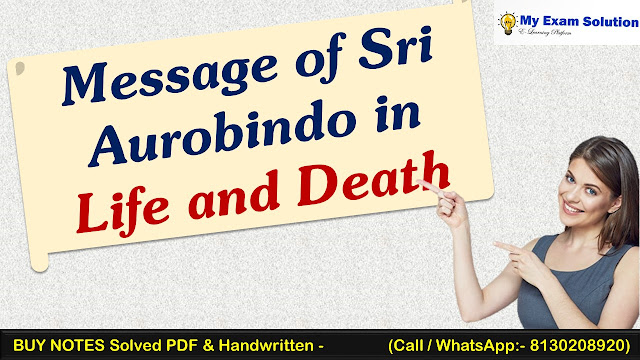Q. Message of Sri Aurobindo in Life and Death
Introduction
Message of Sri Aurobindo in Life and Death Sri Aurobindo, a renowned Indian philosopher, poet, and yogi,
penned down the poem 'Life and Death' during his spiritual journey in the early
20th century. This enigmatic poem encapsulates the essence of life's mysteries
and the profound wisdom of embracing death as a transformative force. Through
vivid imagery, intricate metaphors, and a contemplative tone, Sri Aurobindo
delves into the interconnectedness of life and death, presenting a powerful
message that transcends time and space. In this literary analysis, we will
explore the various layers of meaning in the poem, deciphering Sri Aurobindo's
philosophy and vision of existence.
"Life and Death are one
Even as the river and the sea are one"
Here, Sri Aurobindo establishes the overarching theme of
unity, emphasizing that life and death are inseparable and interconnected. He
compares them to the river and the sea, drawing parallels between the flow of
life and the ultimate merging with the vastness of death. This metaphor sets
the tone for the entire poem, inviting readers to contemplate the profound
truths hidden within the apparent dichotomy of existence.
In the subsequent stanzas, Sri Aurobindo explores the
transient nature of life and the cyclical patterns of birth and death. He
portrays life as a fleeting dream, a "pebble" tossed into the
"Infinite Abyss." This imagery suggests that individual lives are
small and insignificant in the grand scheme of the universe. However, the
notion of the "Infinite Abyss" hints at a deeper cosmic
consciousness, implying that death is not an endpoint but a journey into the
boundless.
The poet continues:
"In the self-same sandal tree
A serpent coils inextricably."
In these lines, Sri Aurobindo employs the metaphor of a
sandal tree with a coiled serpent to portray the inseparability of life and
death. The tree symbolizes life, and the serpent symbolizes death. The two
appear distinct, yet they are inherently intertwined. This evokes the idea of
life's inherent duality, where the existence of one cannot be separated from
the other.
Sri Aurobindo further reflects on the impermanence of worldly
pursuits and the inevitability of mortality:
"In the self-same mould of being
With the self-same ceaseless labour
The Immortals fashion deathless Gods.
This was then, and this is now."
Here, the poet suggests that just as ancient civilizations
crafted immortal deities, the essence of life and death remains unchanged in
the present. He reminds us that the quest for immortality lies not in escaping
death but in understanding its significance in the eternal cosmic order. The
ceaseless labor of the "Immortals" hints at the cyclical nature of
creation and dissolution, echoing the Hindu concept of life and death as part
of the grand cosmic dance.
The poem takes a contemplative turn, inviting readers to
transcend the limitations of ordinary perception:
"Who save the sanctified
Can gaze upon the sun that is eternity?"
Sri Aurobindo challenges us to perceive life and death from
an enlightened perspective. He posits that only those who have attained
sanctity, wisdom, or spiritual realization can truly comprehend the eternal
nature of existence. To "gaze upon the sun that is eternity" is to
perceive the underlying unity and interconnectedness of all things.
The poet further explores the idea of mortality and
immortality coexisting:
"In the drama of creation
They are partners in an endless play;
What they achieve is a dance of God
The matted locks of the Unknown."
These lines evoke the concept of the cosmic drama, where life
and death are not adversaries but collaborators in the manifestation of the
Divine. The "matted locks of the Unknown" represent the mysteries of
existence that remain veiled from ordinary perception. The dance of God
symbolizes the harmonious interplay of life and death, both essential in the
grand design of creation.
Conclusion
In the poem 'Life and Death,' Sri Aurobindo imparts a
profound message that transcends the boundaries of time and space. Through
eloquent metaphors and vivid imagery, he unveils the intrinsic unity of life and
death, encouraging readers to see beyond the apparent duality and recognize the
eternal dance of existence. The poem invites us to embrace mortality as an
integral part of the cosmic order and to seek higher truths beyond the
limitations of ordinary perception. Sri Aurobindo's timeless wisdom challenges
us to embark on a spiritual journey, where life and death are not separate
destinations but interconnected phases of the eternal river of existence. As we
reflect on the poet's words, we are reminded of the inherent divinity in all
things and the transformative power of death, leading us to a deeper
understanding of life's mysteries.
For PDF and Handwritten
WhatsApp – 8130208920
MA English or UGC NET Preparation







0 comments:
Note: Only a member of this blog may post a comment.